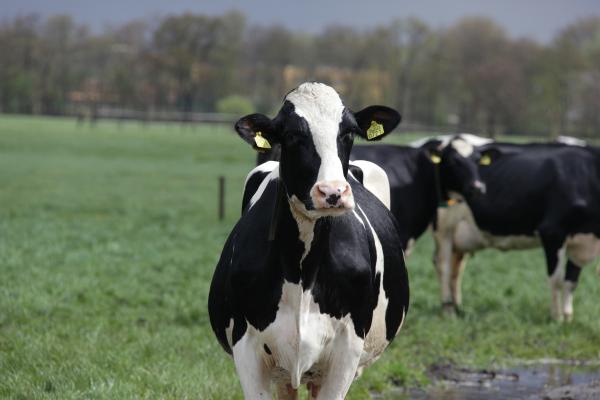A recent study shows that dairy cattle often suffer from vitamin E and β-carotene deficiencies around calving time. This can be detrimental for fertility, udder health and longevity, warns Inne Gantois, nutritionist at DSM Nutritional Products. Extra attention for the levels of vitamin E and β-carotene in dairy rations during the dry period, and transition can contribute to healthy dairy cattle.
[ Written by Carolien Makkink i.c.w. Inne Gantois ]
Vitamin E and β-carotene
Vitamin E is necessary for the proper functioning of various organs and tissues in the body, such as the muscles, and the nervous- circulatory-, reproductive- and immune system. Vitamin E is also a powerful antioxidant that helps to neutralize free radicals in the body. In dairy cattle, an optimal vitamin E status protects against mastitis and optimizes milk production and quality, as well as general animal health and welfare. A good vitamin E supply is essential for a long and productive life of a dairy cow. As a reference, it is commonly accepted that vitamin E should be at least 3.0 mg per liter. Lower levels contribute to a 1 to 9 times higher chance of developing mastitis in the first week after calving. Supplementing the ration with extra vitamin E helps to prevent fertility problems, such as retained fetal membranes. A higher supplementation can help to shorten the interval between calving and the first estrous, as well as reducing the number of inseminations per pregnancy.
Beta-carotene is an antioxidant, a precursor of vitamin A, and is also called the fertility vitamin. It is involved in the synthesis of estrogen and progesterone, and in the development of the follicles. Therefore, β-carotene is important for good follicle quality and protection of the embryo. At the moment - in collaboration with the University of Antwerp - additional research is being conducted about the influence of β-carotene on oocyte quality, says Gantois. A shortage of β-carotene can lead to fertility problems and premature culling of cows. As a reference, β-carotene supply is sufficient at blood levels of 3.5 mg β-carotene per liter of blood. Many cows in transition do not reach this level, so supplementation of rations with β-carotene is needed in many cases, says Gantois.
Transition
Together with two WUR students, DSM determined the vitamin E and β-carotene levels of almost 2500 cows on 127 dairy farms in five different countries (Belgium, the Netherlands, Germany, Spain and Portugal). The samples were taken during the dry period and during lactation. The findings of the study were recently published in the scientific journal Animal. The study clearly shows a drop in blood levels, below the reference, of vitamin E- (Figure 1) and β-carotene (Figure 2) around calving. On day 5 after calving, cows show the lowest levels. This can be explained by the fact that cows often show a dip in feed intake after calving, when large quantities of these vitamins and antioxidants disappear in the colostrum, says Gantois. The lowest levels of vitamin E and β-carotene coincide just at the time when the requirement is increased because of the metabolic stress around calving. Across all stages of production, 75% of the cows sampled in the study had low levels of vitamin E in their blood and 44% were deficient in β-carotene. In the first two weeks after calving almost all cows were vitamin E deficient, half of these cows were still deficient at the end of lactation. In the first two weeks after calving, 78% of the cows were β-carotene-deficient and at the end of the lactation period, 22% of the cows were still deficient.
"There is a ration effect though," explains Gantois: "Grazing cows, which eat fresh grass, get more vitamin E and β-carotene, however even then blood levels are still too low”. In the Netherlands, where grass silage is more abundant in dairy rations, cows have higher β-carotene levels. However, we still find 17% and 55% deficiencies in dry cows and fresh cows, respectively.
Intake lags behind the requirement: "We strive for an intake of at least 1500 mg vitamin E per animal per day during the dry period and at least 750 mg per animal per day during lactation. Even though vitamin E is normally supplemented, we notice large differences between dairy farms. For β-carotene an intake of at least 300 mg per animal per day during the dry period is recommended. As well as for vitamin E, we cannot avoid supplementing the ration with β-carotene," says Gantois.
Investing during dry-off period
To avoid problems during transition, it is important to supply vitamin E and β-carotene already in the dry period, says Gantois: "The primary oocyte already develops in the dry period, so sufficient levels of β-carotene are already essential for good reproduction results. In practice, β-carotene is insufficiently supplemented and the supply through the rations often lags behind: "Fresh grass does contain sufficient β-carotene, but mowing and ensiling reduces the content enormously. In addition, we advise against feeding too much grass silage in dry rations because of the risk for milk fever," warns Gantois. Other roughages, such as alfalfa and maize silage, contain too little β-carotene.
By providing extra vitamin E and β-carotene in the dry period, the cow starts the lactation phase with extra reserves. Research shows that animals with higher vitamin E and β-carotene status in the dry period also have higher blood values at the beginning of lactation. Gantois recommends a supplementation of at least 1500 mg vitamin E and 300 mg β-carotene per animal per day during the dry period, for a good start of lactation: "Ideally, we would also supplement in the first weeks after calving, but this is less feasible in practice, where often different production groups are not used. DSM research shows that during the dry period, vitamin E is already quite commonly supplied in The Netherlands, while in Spain and Portugal this is not yet the case. Supplementation of β-carotene also varies widely between countries.
Advice
About a quarter of the premature culling of dairy cows in practice is attributed to fertility problems. A good vitamin E and β-carotene supply can help prevent this, resulting in better business results, a longer productive life of the dairy herd, better animal health and welfare, a more sustainable dairy chain and an increase in the social acceptance of livestock farming.
Based on the ration composition, DSM can provide optimal advice on the best dosage of vitamin E and β-carotene in each phase of the life of a high yielding dairy cow.
.png)
Figure 1 Vitamin E content in blood of dairy cattle, with different feed systems
.png)
Figure 2 Beta-carotene content in the blood of dairy cattle, with different feeding systems


